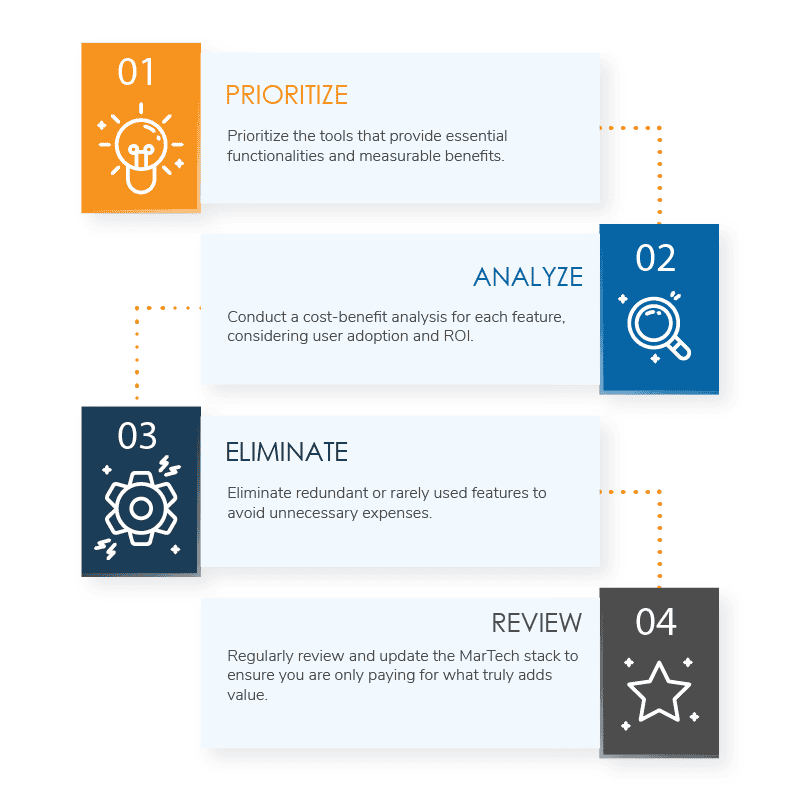
1. Manage Your Database Size
Many MarTech vendors align pricing to database size or user count. The larger your database, the more the tool will cost. This is why auditing your head count for users and subscribers in the database regularly is essentially for maintaining your budget. Admins should regularly consider:
- Removing duplicates, outdated information, and inactive contacts
- Implement strict data entry protocols to prevent unnecessary growth
- Use automated tools to manage data quality and storage efficiently
- Limit data collection to essential information only
- Periodically review storage needs to avoid overpaying for unused capacity.
2. Scrutinize Features
When considering a new MarTech platform, evaluate individual features based on their direct impact on your business goals. We use this simple 4-step approach when evaluating vendors during the selection process:
- We prioritize tools that provide essential functionalities and measurable benefits
- We conduct a cost-benefit analysis for each feature, considering user adoption and ROI
- We make sure to eliminate redundant or rarely used features to avoid unnecessary expenses
- We regularly review and update the MarTech stack to ensure we are only paying for what truly adds value.
If your tech stack includes a CRM platform with advanced analytics and social media integration, but your team primarily uses it for basic contact management and email campaigns, you might be overpaying for features you don’t need or that are rarely used. By switching to a simpler CRM that focuses on the core functions you actually use, you can reduce costs without compromising productivity.

3. Renegotiate Early for the Best Deal
You might think you’re stuck with whatever pricing and terms your MarTech vendor offers you, but organizations often have more negotiating power than they realize.
You can approach vendors before your contract ends to leverage competitive pricing and negotiate for long-term agreements to lock in lower rates and gain additional discounts.
Make sure your contract includes favorable terms and the flexibility to adjust services as needed. This proactive approach helps avoid unexpected cost increases and optimizes your overall budget.
4. Work with Other Departments
To make the most of your budget, plan to collaborate with other departments like IT or Sales.
When your needs are aligned with other departments, and a net benefit exists across both, the cost of new platforms can be shared to cover the costs and maximize resource utilization.
Pooling funds can lead to better deals and comprehensive solutions benefiting multiple teams and this interdepartmental cooperation leads to efficient spending and enhanced overall operational effectiveness–without exceeding your budget.
5. Join Beta Programs
Have you considered beta programs? If your requirements are flexible, and your organization or department is willing to work with a vendor to help them build out their product offering, this is an excellent path to take to keep your MarTech spend within budget.
Beta programs often offer early access to new features at low or reduced rates to help drive adoption or to test out new features and functionality.
Participating in beta programs allows you to influence product development, increasing the likelihood that the features align with your needs.

Effective MarTech budget management is key to sustaining growth and achieving business goals. By keeping your database size and user licenses in check, scrutinizing features, renegotiating early, collaborating with other departments, and joining beta programs, you can optimize your spend and achieve maximum ROI. Implement these strategies to maintain financial discipline and drive your marketing efforts forward efficiently.